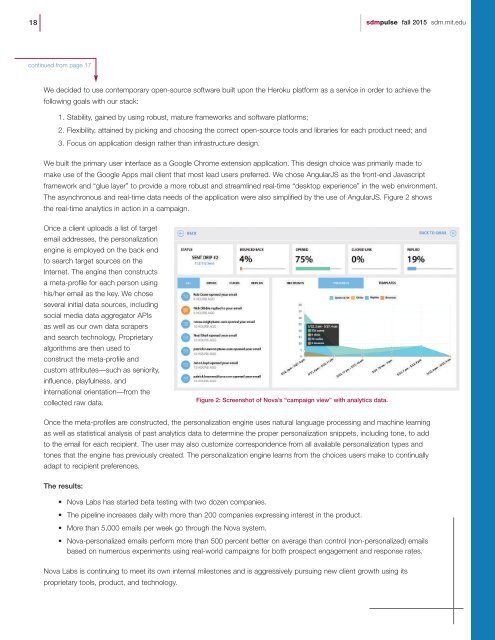sdm pulse
SDM-Pulse-Fall-2015
SDM-Pulse-Fall-2015
Create successful ePaper yourself
Turn your PDF publications into a flip-book with our unique Google optimized e-Paper software.
18 <strong>sdm</strong><strong>pulse</strong> fall 2015 <strong>sdm</strong>.mit.edu<br />
continued from page 17<br />
We decided to use contemporary open-source software built upon the Heroku platform as a service in order to achieve the<br />
following goals with our stack:<br />
1. Stability, gained by using robust, mature frameworks and software platforms;<br />
2. Flexibility, attained by picking and choosing the correct open-source tools and libraries for each product need; and<br />
3. Focus on application design rather than infrastructure design.<br />
We built the primary user interface as a Google Chrome extension application. This design choice was primarily made to<br />
make use of the Google Apps mail client that most lead users preferred. We chose AngularJS as the front-end Javascript<br />
framework and “glue layer” to provide a more robust and streamlined real-time “desktop experience” in the web environment.<br />
The asynchronous and real-time data needs of the application were also simplified by the use of AngularJS. Figure 2 shows<br />
the real-time analytics in action in a campaign.<br />
Once a client uploads a list of target<br />
email addresses, the personalization<br />
engine is employed on the back end<br />
to search target sources on the<br />
Internet. The engine then constructs<br />
a meta-profile for each person using<br />
his/her email as the key. We chose<br />
several initial data sources, including<br />
social media data aggregator APIs<br />
as well as our own data scrapers<br />
and search technology. Proprietary<br />
algorithms are then used to<br />
construct the meta-profile and<br />
custom attributes—such as seniority,<br />
influence, playfulness, and<br />
international orientation—from the<br />
collected raw data.<br />
Figure 2: Screenshot of Nova’s “campaign view” with analytics data.<br />
Once the meta-profiles are constructed, the personalization engine uses natural language processing and machine learning<br />
as well as statistical analysis of past analytics data to determine the proper personalization snippets, including tone, to add<br />
to the email for each recipient. The user may also customize correspondence from all available personalization types and<br />
tones that the engine has previously created. The personalization engine learns from the choices users make to continually<br />
adapt to recipient preferences.<br />
The results:<br />
• Nova Labs has started beta testing with two dozen companies.<br />
• The pipeline increases daily with more than 200 companies expressing interest in the product.<br />
• More than 5,000 emails per week go through the Nova system.<br />
• Nova-personalized emails perform more than 500 percent better on average than control (non-personalized) emails<br />
based on numerous experiments using real-world campaigns for both prospect engagement and response rates.<br />
Nova Labs is continuing to meet its own internal milestones and is aggressively pursuing new client growth using its<br />
proprietary tools, product, and technology.


